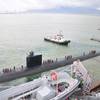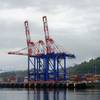The Norwegian Sea could be a safe dumping ground for carbon dioxide (CO2), a gas blamed for global warming, Norway's Nansen Environmental and Remote Sensing Center said. The center has proposed a research project where liquid CO2 would be pumped directly from offshore oil and gas fields to the deep waters of the Norwegian Sea to see if it could be stored there safely.
The project will ascertain whether CO2 pumped 800 m down into the Norwegian Sea will dissolve and spread to the Atlantic Ocean before eventually being neutralized by ocean bed sediments.
"The oceans already absorb carbon dioxide from the atmosphere, but this can take up to a thousand years," Helge Drange, research leader at the center, said. "Pumping CO2 under water like this can be seen as an acceleration of a natural process."
CO2 is one of the main so-called "greenhouse gases" scientists say are trapping heat in the atmosphere and pushing up world temperatures. He said that CO2 would have to be pumped to as deep as 2,000-3,000 m in seas that were not as cold and dense as the Norwegian Sea. Such depth would increase expense.
Drange said the feasibility of underwater CO2 storage was subject to both financial and environmental considerations. "It costs money to remove CO2 from exhaust fumes", he said.
Pumping CO2 underwater would be more environmentally friendly than a tax on CO2 emissions which oil companies operating in the Norwegian Sea are obliged to pay the government.
"The tax is 350 crowns per ton of CO2 that is burned, while the cost of depositing CO2 underwater would be about 350-400 crowns per ton of CO2," he said. "It's expensive, but it's not an economic Utopia."
But dissolved carbon dioxide -- which increases the acidity of the sea water -- could damage fish and other marine life. "Marine organisms will be stressed by the carbon dioxide," Drange said.
The Norwegian Sea, a deep basin off Norway's northwestern coast, has oil and gas fields where carbon dioxide is produced as a by-product.
Funding for the project has come from Norwegian industrial group Norsk Hydro, state oil firm Statoil, the Norwegian state and the European Commission.
The project has been proposed by the Nansen Center in a paper scheduled for release in the July 1 edition of Geophysical Research Letters, published by the American Geophysical Union. A month-long test pumping 40-60 tons of liquid CO2 off the coast of Hawaii, and jointly conducted by the United States, Japan, Canada, Australia and Norway, is scheduled to take place in the autumn.
Featured videos

Tracking Foreign Vessels Working in the U.S. Jones Act Market

Unlock Onboard Data Efficiencies

Inmarsat Enhances Service to Drive Digitalization
Subscribe for
Maritime Reporter E-News
Maritime Reporter E-News is the maritime industry's largest circulation and most authoritative ENews Service, delivered to your Email five times per week









